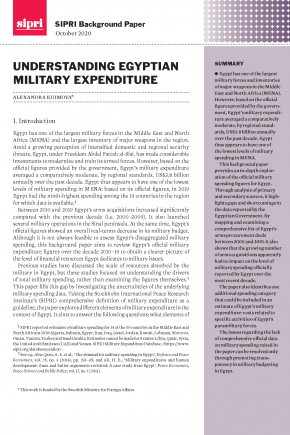Understanding Egyptian Military Expenditure
Egypt has one of the largest military forces and inventories of major weapons in the Middle East and North Africa (MENA). However, based on the official figures provided by the government, Egypt’s military expenditure averaged a comparatively moderate, by regional standards, US$3.8 billion annually over the past decade. Egypt thus appears to have one of the lowest levels of military spending in MENA.
This background paper provides an in-depth exploration of the official military spending figures for Egypt. Through analysis of primary and secondary sources, it highlights gaps and shortcomings in the data reported by the Egyptian Government. By mapping and examining a comprehensive list of Egypt’s arms procurement deals between 2000 and 2019, it also shows that the growing number of arms acquisitions apparently had no impact on the level of military spending officially reported by Egypt over the most recent decade.
The paper also identifies one additional spending category that could be included in an estimate of Egypt’s military expenditure: costs related to specific activities of Egypt’s paramilitary forces.
The issues regarding the lack of comprehensive official data on military spending raised in the paper can be resolved only through promoting transparency in military budgeting in Egypt.
I. Introduction
II. Definitions, methods and sources
III. Egyptian military spending in economic and regional contexts
IV. ‘Defence and national security’: Budget composition
V. Outside Egypt’s military budget: Egypt’s spending on paramilitary forces
VI. Spending on arms procurement
VII. Beyond the budget: The Egyptian armed forces’ economic activities
VIII. Conclusions

